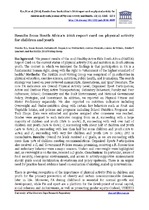| dc.description.abstract | Background: We present results of the 2016 Healthy Active Kids South Africa (HAKSA) Report Card on the current status of physical activity (PA) and nutrition in South African youth. The context in which we interpret the findings is that participation in PA is a fundamental human right, along with the right to "attainment of the highest standard of health." Methods: The HAKSA 2016 Writing Group was comprised of 33 authorities in physical education, exercise science, nutrition, public health, and journalism. The search strategy was based on peer-reviewed manuscripts, dissertations, and 'gray' literature. The core PA indicators are Overall Physical Activity Level; Organized Sport Participation; Active and Outdoor Play; Active Transportation; Sedentary Behaviors; Family and Peer Influences; School; Community and the Built Environment; and National Government Policy, Strategies, and Investment. In addition, we reported on Physical Fitness and Motor Proficiency separately. We also reported on nutrition indicators including Overweight and Under-nutrition along with certain key behaviors such as Fruit and Vegetable Intake, and policies and programs including School Nutrition Programs and Tuck Shops. Data were extracted and grades assigned after consensus was reached. Grades were assigned to each indicator ranging from an A, succeeding with a large majority of children and youth (81% to 100%); B, succeeding with well over half of children and youth (61% to 80%); C, succeeding with about half of children and youth (41% to 60%); D, succeeding with less than half but some children and youth (21% to 40%); and F, succeeding with very few children and youth (0% to 20%); INC is inconclusive. Results: Overall PA levels received a C grade, as we are succeeding with more than 50% of children meeting recommendations. Organized Sports Participation also received a C, and Government Policies remain promising, receiving a B. Screen time and sedentary behavior were a major concern. Under-and over-weight were highlighted and, as overweight is on the rise, received a D grade. Conclusion: In particular, issues of food security, obesogenic environments, and access to activity-supportive environments should guide social mobilization downstream and policy upstream. There is an urgent need for practice-based evidence based on evaluation of existing, scaled up interventions. | en_US |

